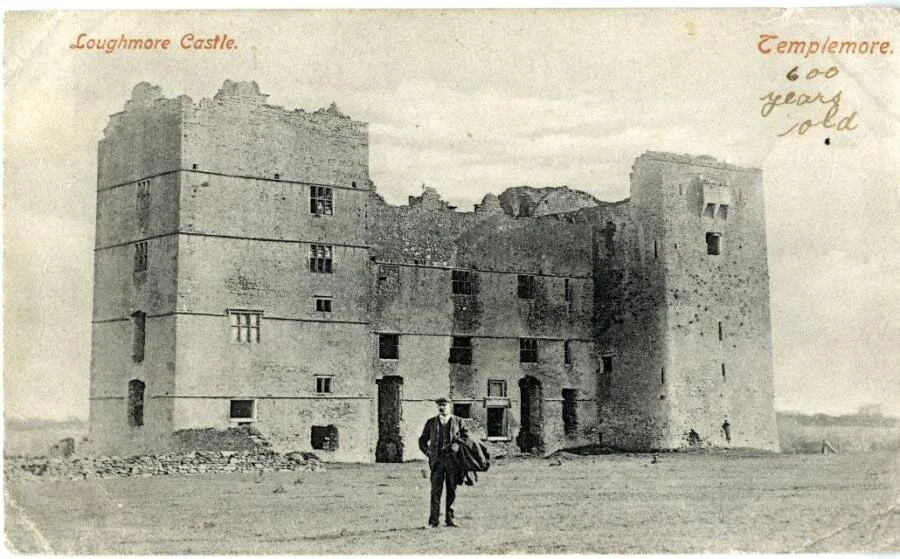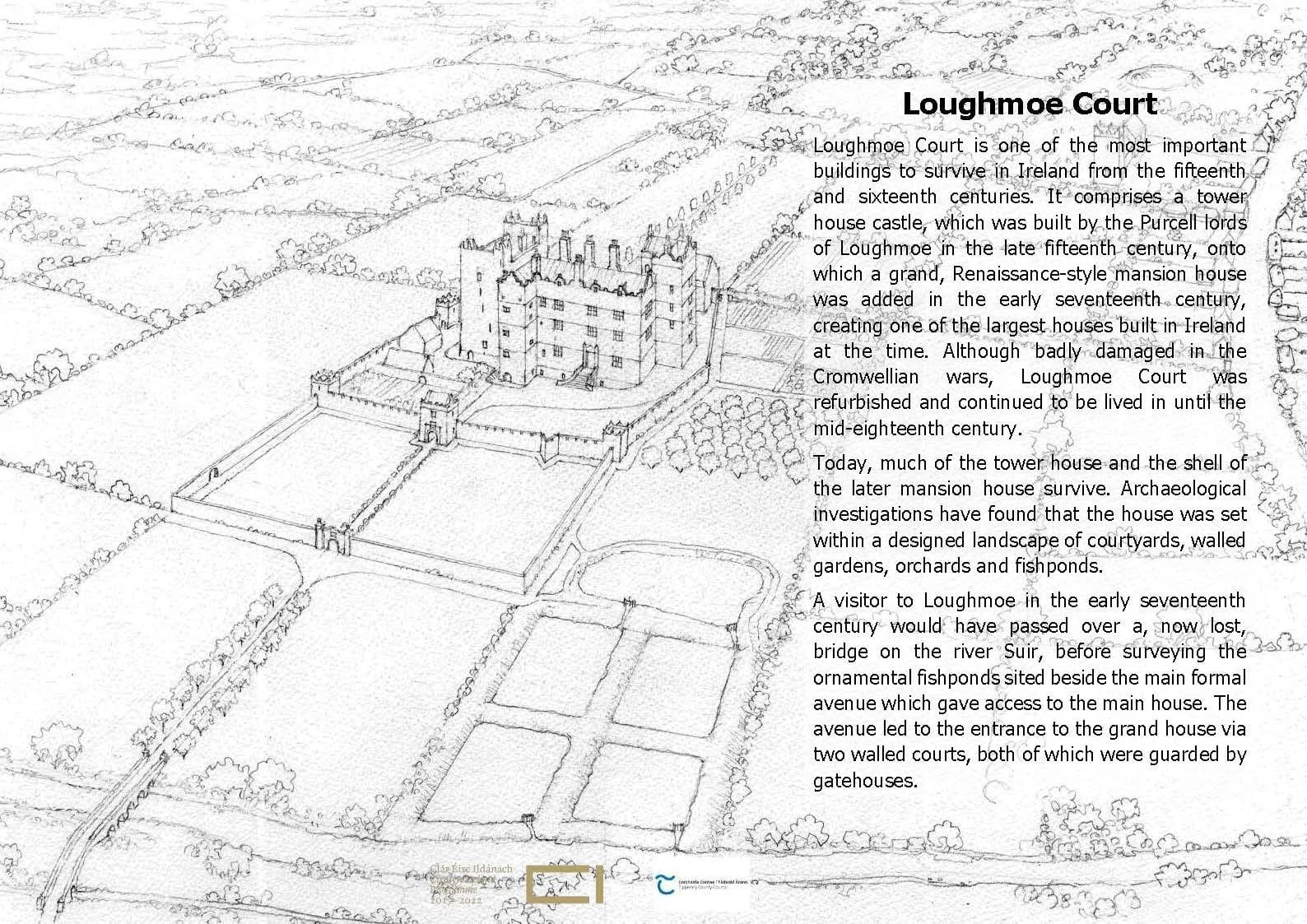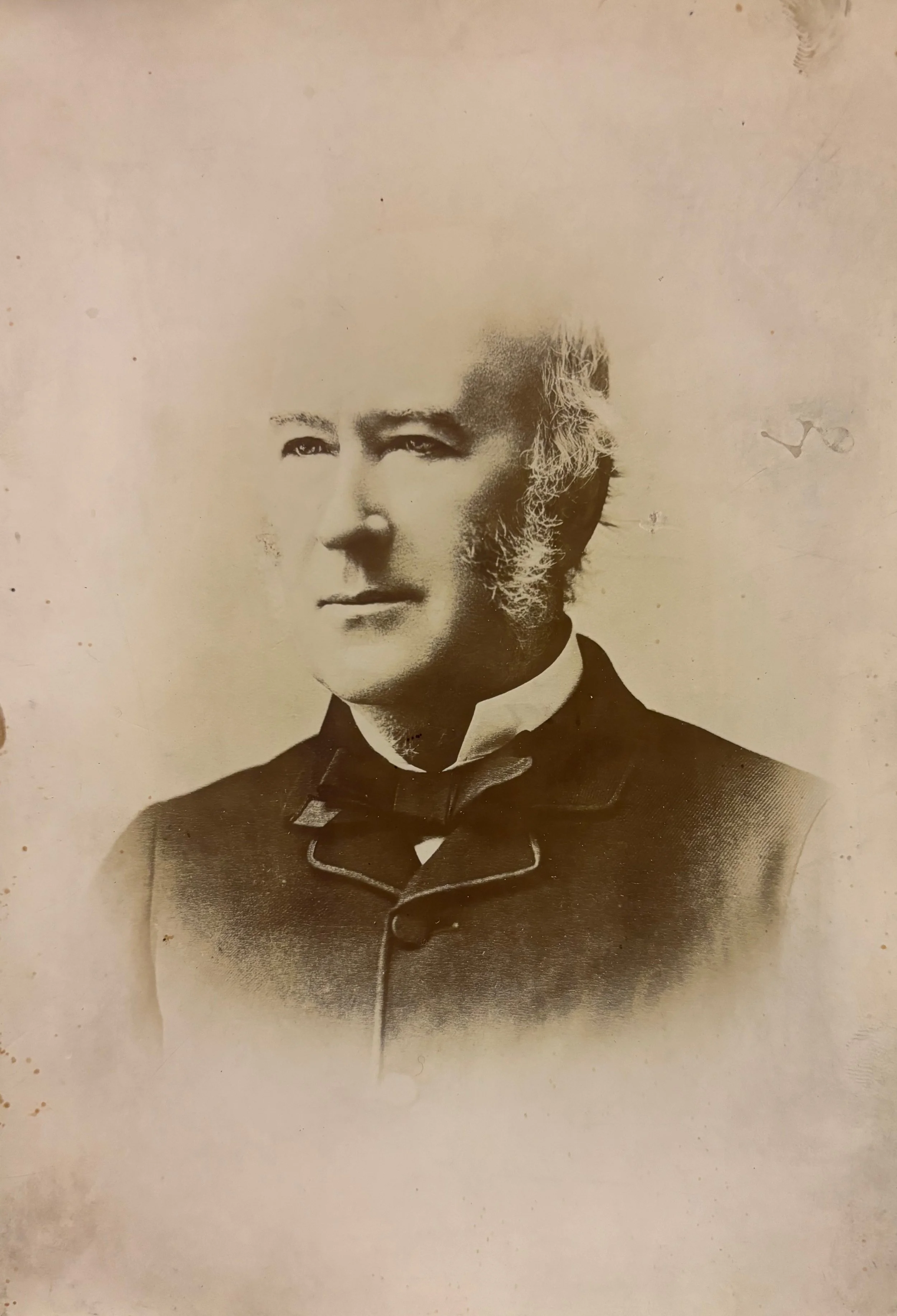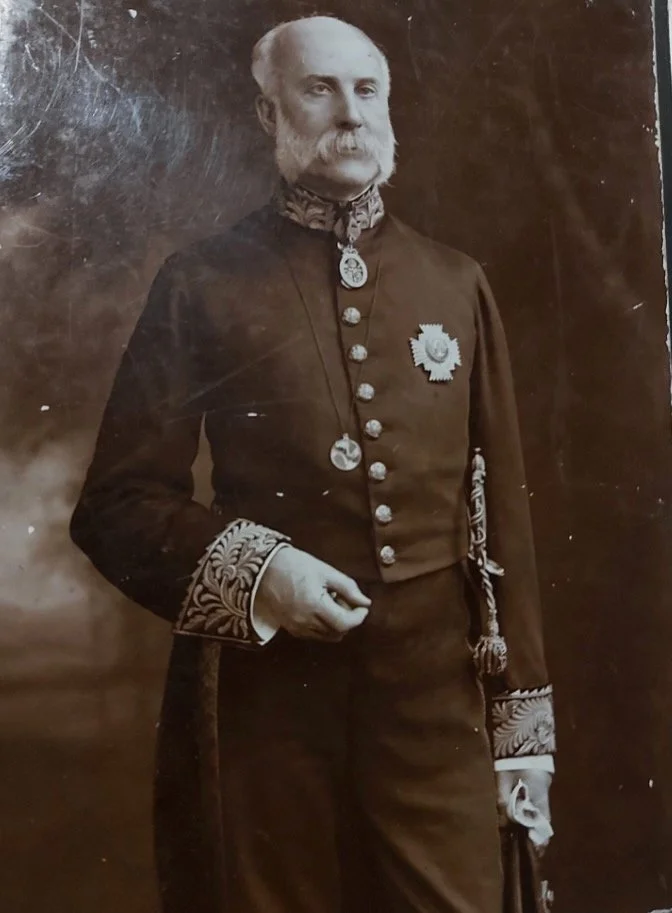PHOTOGRAPHS
Loughmoe Castle (Loughmore, near Templemore, Co. Tipperary) in the late 19th or early 20th century. The heads of the Purcell family lived on their Loughmoe lands from circa 1220 to 1722. (This view depicts the rear of the castle.)
Loughmoe Castle in the 1920s or early 1930s. Recent testing has determined that the oldest surviving section of the castle, the south tower or keep, on the far right of the photograph, was built between 1444 and 1494. James Purcell, alive in 1465, was Baron of Loughmoe during some of this period.
This painting depicts Loughmoe Castle from the front, as it likely would have looked in its heyday, before the Cromwellian destruction of the 1650s.
Loughmoe Castle, seen from the front, as it looks today
Holy Cross Abbey in Co. Tipperary. James Purcell, Baron of Loughmoe (alive in 1465) is buried there. At the Reformation, Henry VIII dissolved this ancient Roman Catholic (Cistercian) abbey. The last abbot prior to the Reformation was Abbot Philip Purcell (d. 1563), a younger brother of a later James Purcell, Baron of Loughmoe. Until the Reformation, Philip is said to have sat in the Irish House of Lords as a lord spiritual.
Foulksrath Castle in Co. Kilkenny was the seat of the Purcells of Foulksath until the Cromwellian confiscations of the 1650s. The Purcells of Foulksrath were a junior branch of the Purcells of Loughmoe. In the 20th century, the late Hubert Butler, co-founder of The Butler Society, saved the castle from destruction by persuading its owner not to pull it down. In the 1990s, it was a youth hostel.
A Purcell grave slab on the floor of St. Canice’s Cathedral, Kilkenny. This is the tomb of James Purcell of the Garrans, Co. Kilkenny (died 1552), a younger son of Philip Purcell of Foulksrath Castle (alive in 1491). James had at least 9 sons and many Kilkenny Purcells likely descend from him. The upper shield or coat of arms shows the boars’ heads of the Purcells. The lower shield is the coat of arms of his wife, Johanna Shortall.
ABOVE: Grave slab on the floor of St. Canice’s Cathedral, Kilkenny of Captain Edmund Purcell (d. 1549), captain of the Earl of Ormond’s gallowglasses. Gallowglasses were in effect mercenaries, often from the west of Scotland. They were armoured heavy infantrymen. By May 1544, James Butler, 9th Earl of Ormond, had raised 200 light infantrymen (kerne) in response to King Henry VIII’s call for troops to fight in Scotland and France. Lord Ormond’s nephew James Butler (brother of the Lord Dunboyne) was named captain commanding 100 of these soldiers, and Edmund Purcell was named captain commanding the other 100 infantrymen. These were part of an Irish force of 1000 soldiers, “picked men”, who travelled to England, half of whom were designated to fight in Scotland and the other half to participate in Henry VIII’s invasion of France.
BELOW: The image below shows how these Irish kerne would have looked at the siege of Boulogne in 1544. It is an engraving taken from a contemporary painting later destroyed in a fire. The Irish soldiers, led by a piper and preceded by captured cattle, wear coats and mantles and carry darts or spears. Some have swords.
This tomb of a Purcell couple may be seen in the ruins of St. John’s Priory, Kilkenny. Canon Carrigan, the historian of the Diocese of Ossory, thought that this was probably the tomb of Edmund Purcell of Ballyfoyle (the head of the Ballyfoyle branch of the Purcells of Loughmoe) and his wife Margaret Cantwell. Edmund Purcell, on horseback, was slain in 1625 in Kilkenny by a blow to his neck from the sword of a Blanchville (Blanchfield) during a quarrel with Sir Edmund Blanchville. Edmund Purcell’s son Philip Purcell of Ballyfoyle Castle was one of the leaders of the Catholic Confederation in the 1640s. Philip married Ellen Butler, daughter of the 3rd Viscount Mountgarret, the head of a junior line of the Butlers of Ormond.
This faded document, dated 26 October 1691 and now on display in the Royal Welch Fusiliers Regimental Museum, is the original commission issued to Lieutenant-Colonel Tobias (Toby) Purcell, 23rd Foot, promoting him to Colonel of Infantry in the Army of King William III and placing him in command of the 23rd Regiment of Foot (later the Royal Welch Fusiliers). The commission is signed at the top left by King William III and is signed at the bottom by the Earl of Nottingham, secretary of state. Purcell, a professional Army officer born in Ireland and a descendant of the Purcells of Rorestown, Co. Tipperary, a junior branch of the Purcells of Loughmoe, was second in command of the 23rd Foot at the battle of Aughrim on 12 July 1691, when the regimental commander, Colonel Charles Herbert, was killed in action. The next day, King William III appointed Purcell to replace Herbert, but the formal commission was not signed until October. Colonel Toby Purcell was an Anglican and anti-Jacobite. He thus fought at the Boyne and Aughrim on the opposite side from his cousin, the head of the House of Purcell, Colonel Nicholas Purcell. Colonel Nicholas Purcell, Baron of Loughmoe, a Roman Catholic and Jacobite, commanded a cavalry regiment, Purcell’s Horse, in both battles. In his autobiography Good-bye to All That, the writer and poet Robert Graves, a Captain of the Royal Welch Fusliers who was badly wounded in World War I, reminisced about the regiment’s annual St. David’s Night dinner, in which the fourth toast of the evening was to “Toby Purcell, his spurs, and St. David.” The toast was continued annually until at least 2006, when the Royal Welch Fusiliers were merged into another regiment. The spurs referred to those worn by Toby Purcell at the battle of the Boyne, when he was a Lieutenant-Colonel and second in command of the regiment. Purcell’s spurs were preserved and handed down to successive seconds in command of the regiment, until they were lost in Montreal in 1842.
This miniature portrait in watercolour was recently sold at auction. The reverse side of the miniature bore the name “Toby Purcell” and the date 1779. On a consideration of dates, this miniature may well depict Captain Tobias Purcell (1738-1825), 1st Fencible Light Dragoons, of Timogue Castle, Queen’s County (Co. Laois), some 25 miles or so from Kilkenny. His sons included James Purcell, a British army officer on the staff of General Evans in Spain in the 1830s during the First Carlist War, and Rear Admiral Edward Purcell, Royal Navy (1792-1869). His grandsons included two British army officers, Colonel Matthew Henry Purcell, Royal Engineers, and Colonel Edward Tobias Willoughby Purcell, Royal Artillery. They were descendants of the Purcells of Esker, Co. Kilkenny, an offshoot of the Purcells of Loughmoe.
Portrait of Lieutenant Colonel John Purcell (died 1852), husband of the heiress Mary Frances FitzGerald. After his wife inherited from her father, John Purcell took the name and arms of FitzGerald in 1818 and became John FitzGerald. They owned the castle at the Little Island, Co. Waterford, a photograph of which appears in the Heraldry section of this website. He was a Member of Parliament and was High Sheriff of Suffolk. His elder son changed their surname to Purcell-FitzGerald in 1858. The younger son, Edward FitzGerald (who until age 9 in 1818 was Edward Purcell), was the translator of the Rubáiyát of Omar Khayyám
The best known Purcell in 19th century North America was John Baptist Purcell (1800-1883), first Roman Catholic Archbishop of Cincinnati, Ohio. He was born in Mallow, Co. Cork. Pope Pius IX created him a Count in 1851. His biography in the Dictionary of American Biography states: “Though of conspicuous family, his parents were in poor circumstances.”
Sir John Purcell of Highfort, Co. Cork was knighted by the Prince Regent in 1811 for defending himself with a knife against a band of robbers. The portrait shows him holding the knife he used. He is the ancestor of the Purcells of Burton Park, Co. Cork, who still have the knife in their possession. His line descended from the Purcells of Croagh, Co. Limerick, an offshoot of the Purcells of Loughmoe.
Engraving of Colonel Baron Johann Purcell von Rorestown, who was born in Vukovár, Croatia in 1771 and died in Szekler Neumarkt, Hungary (now Târgu Secuiesc, Romania) in 1829. From 1817 until his death, Johann Purcell commanded in Hungary the 2nd Szeckler Border Infantry Regiment No. 15 in the army of the Austrian emperor. In 1807, during the Napoleonic Wars, he commanded, as a Major of Infantry, the Imperial and Royal Battalion Purcell, a Hungarian battalion. He was the son of Major General Baron Johann Baptist Purcell von Rorestown (1721-1779), a cavalry officer in the army of the Holy Roman Emperor. Born in Kilkenny, Ireland, as John Baptist Purcell, the latter became an officer in the Emperor’s service at age 21. He was a descendant of the Purcells of Rorestown, Co. Tipperary, a junior line of the Purcells of Loughmoe. Based upon his descent from the Barons of Loughmoe, and after being awarded the Order of Maria Theresa for gallantry in battle as a Captain of Cavalry, Johann Baptist Purcell secured recognition from the Emperor of baronial rank for him and his descendants, as Barons Purcell von Rorestown.
Judge Theobald Andrew Purcell (1818-1894) (B.A. 1839; M.A. 1866, Trinity College, Dublin), of 71 Harcourt Street, Dublin, was a circuit judge in Ireland in the 1870s and 1880s. Among his American grandchildren, from San Gabriel, California, were two U.S. Army officers who served during World War I: Colonel Launcelot Purcell and Lieutenant Colonel Burgo Purcell (the latter also served during World War II). His great-grandson, the late Major Hugh Devereux Purcell (1915-1993), also of California, a U.S. Army veteran of World War II, did extensive research on the Jacobite regiment of horse commanded from 1689 to 1691 by Colonel Nicholas Purcell, last Baron of Loughmoe.
The photograph above is of Sir John Samuel Purcell, KCB, JP (1839-1924). He was born in Carrick-on-Suir, Co. Tipperary, the son of Dr. John F. Purcell, M.D., a Commissioner of Irish Poor Laws. Sir John began his long career in the British Civil Service in 1856 at age 17. He rose to the position of Comptroller of Stamps and Stores and Registrar of Joint Stock Companies for the Inland Revenue Department. In 1887, he played a prominent role in selecting postage stamps to commemorate the Golden Jubilee of Queen Victoria. In 1900, at his retirement after more than 40 years in the Civil Service, Queen Victoria, months before the end of her long reign, created him a Knight Commander of the Order of the Bath. He formerly held the rank of Major, London Irish Rifle Volunteers. In retirement, he was chairman of the National Bank (formerly National Bank of Ireland) and also of St. John’s Hospital, Lewisham. In his later years, he lived at Glebe Lodge, Blackheath, London SE 3.
Baron Emil Purcell von Rorestown (1876-1935) in the uniform of a Hungarian army officer. A great-grandson of Colonel Baron Johann Purcell von Rorestown, shown in a photograph above, Baron Emil Purcell emigrated from Budapest to New York City in 1902 and eventually settled in San Francisco, where he raised his three sons.
Colonel John Purcell (1880-1954) served as a U.S. Army officer in both world wars. During World War I, as a Major of Infantry, he commanded a battalion of the 58th Pioneer Infantry. When the United States entered the Second World War, he was recalled from retirement to active duty at age 61 and served for the duration of the war. His family descended from the Purcells of Conahy, Co. Kilkenny, an offshoot of the Purcells of Foulksrath and in turn of the Purcells of Loughmoe.
Lieutenant Charles Francis Purcell, an infantry officer of the Irish Guards, was killed in action at the Battle of the Somme in France in 1916. He was 24 years old. Educated at Oxford, he was a Purcell of Burton Park, Co. Cork. His elder brother Major Raymond John Purcell, D.S.O, of Burton Park, an infantry officer in the King’s Royal Rifle Corps, was badly wounded in France during World War I and died in 1928.
A photograph of the temporary wooden cross that used to mark the war grave in France of Major Richard Guy Purcell, M.C., Royal Garrison Artillery, until a permanent stone marker was put in place at the Faubourg d’Amiens British Cemetery, Arras, France. The wooden cross is now in St. George’s Church, Damerham, Hampshire. Major Richard Guy Purcell (1888-1918), of White House, Ferring, Worthing in England, was the highest ranking Purcell to die as a soldier in the British Army in World War I. He was killed in action near Tilloy Wood in France in March 1918 at age 30 during the defense of Arras. He was survived by his widow, his daughter, and his father. Major Purcell was commissioned a Second Lieutenant of Artillery in 1907 after completing training at the Royal Military Academy. He was the son of Colonel Matthew H. Purcell, Royal Engineers, son of Rear Admiral Edward Purcell, Royal Navy (who as a young midshipman served in sea engagements during the Napoleonic Wars), son of Captain Tobias Purcell, 1st Fencible Light Dragoons, of Timogue Castle, Co. Laois, Ireland, who was a descendant of the Purcells of Esker, Co. Kilkenny, a junior line of the Purcells of Loughmoe.
The year 2021 marks the centenary of the death of Lieutenant Martin Purcell, Irish Volunteers, who grew up in Clonkelly, Dundrum, Co. Tipperary, about 18 miles from Loughmoe Castle. He was killed in Tipperary on 30 May 1921 at age 19 during the Irish War of Independence. The above photograph is of a Roman Catholic baptismal font in Dundrum which was given in memory of Lieutenant Purcell. In December 1918, weeks after the end of World War I, a general election was held throughout the United Kingdom of Great Britain and Ireland. Of the 105 parliamentary seats in Ireland, 73 seats were won by candidates committed to an Irish republic independent of Great Britain. These 73 Irish Members of Parliament declined to take their seats at Westminster and instead formed an Irish parliament, Dáil Éireann, in Dublin. Impelled in part by Woodrow Wilson’s precept of a national right of self-determination, which was a key principle at the post-World War I peace conference at Versailles, these Irish legislators believed that, having stood on an independence platform and having won 70% of Ireland’s parliamentary seats in a free election, they had the right to declare national independence. The British Government viewed their actions as sedition and sent military and paramilitary forces to Ireland to suppress the rebellion. Dáil Éireann in turn recognized the Irish Volunteers (Óglaigh na hÉireann) as the national army of Ireland. A war ensued. The truce in July 1921, which ended the fighting, was followed by a 1922 treaty between Great Britain and Ireland which recognized an Irish Free State. More than twenty years after his death, Martin Purcell was posthumously decorated by the Irish Government for his service in the War of Independence. In recent decades, other Purcells have served in today’s Irish Defence Forces (Óglaigh na hÉireann), including Brigadier General (retired) Patrick Purcell of Naas, Co. Kildare (originally of Kilkenny), who was also a vice president of the Military History Society of Ireland.
The remarkable career of Lieutenant Colonel Herbert Purcell, MBE (1910-2000) exemplifies the long military traditions of the Purcells. Born in Dublin, Colonel 'Percy' Purcell spent several years as a pilot and officer in the RAF (1929-1934). From 1935 until his retirement in 1947, he was an infantry officer of the Indian Army, eventually commanding battalions of both the 1st Gurkha Rifles and the 3rd Gurkha Rifles. He saw action on the Northwest Frontier before World War II and in Malaya after the war. During World War II, he fought the Japanese in Burma and in French Indochina. In Burma, his battalion participated in the crossing of the mile-wide Irrawaddy River, the longest opposed river crossing of the war. As Commander, Southern Sector, Saigon in 1945, he accepted the sword of surrender from the local Japanese commander. After his retirement from the Army, he returned to Ireland to live. Colonel Purcell was an outstanding athlete (rugby, boxing and tennis) and also an accomplished equestrian who played polo, competed as a jockey and served as a Master of Hounds.
























